The Intel Xeon W-3175X Review: 28 Unlocked Cores, $2999
by Ian Cutress on January 30, 2019 9:00 AM ESTCPU Performance: Office Tests
The Office test suite is designed to focus around more industry standard tests that focus on office workflows, system meetings, some synthetics, but we also bundle compiler performance in with this section. For users that have to evaluate hardware in general, these are usually the benchmarks that most consider.
All of our benchmark results can also be found in our benchmark engine, Bench.
For our graphs, some of them have two values: a regular value in orange, and one in red called 'Intel Spec'. ASUS offers the option to 'open up' the power and current limits of the chip, so the CPU is still running at the same frequency but is not throttled. Despite Intel saying that they recommend 'Intel Spec', the system they sent to us to test was actually set up with the power limits opened up, and the results they provided for us to compare to internally also correlated with that setting. As a result, we're providing both sets results for our CPU tests.
PCMark 10: Industry Standard System Profiler
Futuremark, now known as UL, has developed benchmarks that have become industry standards for around two decades. The latest complete system test suite is PCMark 10, upgrading over PCMark 8 with updated tests and more OpenCL invested into use cases such as video streaming.
PCMark splits its scores into about 14 different areas, including application startup, web, spreadsheets, photo editing, rendering, video conferencing, and physics. We post all of these numbers in our benchmark database, Bench, however the key metric for the review is the overall score.
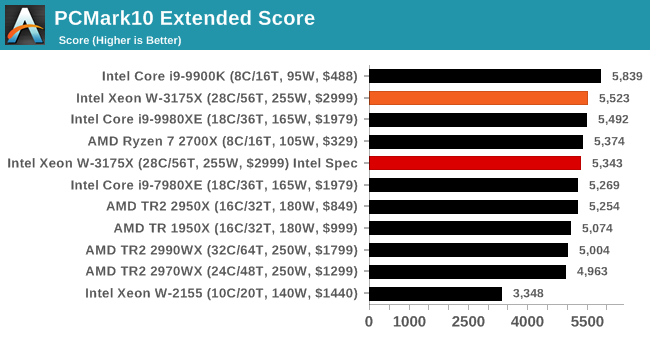
.
Chromium Compile: Windows VC++ Compile of Chrome 56
A large number of AnandTech readers are software engineers, looking at how the hardware they use performs. While compiling a Linux kernel is ‘standard’ for the reviewers who often compile, our test is a little more varied – we are using the windows instructions to compile Chrome, specifically a Chrome 56 build from March 2017, as that was when we built the test. Google quite handily gives instructions on how to compile with Windows, along with a 400k file download for the repo.
In our test, using Google’s instructions, we use the MSVC compiler and ninja developer tools to manage the compile. As you may expect, the benchmark is variably threaded, with a mix of DRAM requirements that benefit from faster caches. Data procured in our test is the time taken for the compile, which we convert into compiles per day.
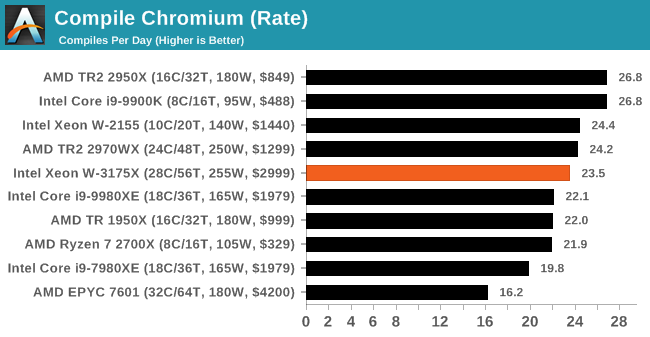
.
3DMark Physics: In-Game Physics Compute
Alongside PCMark is 3DMark, Futuremark’s (UL’s) gaming test suite. Each gaming tests consists of one or two GPU heavy scenes, along with a physics test that is indicative of when the test was written and the platform it is aimed at. The main overriding tests, in order of complexity, are Ice Storm, Cloud Gate, Sky Diver, Fire Strike, and Time Spy.
Some of the subtests offer variants, such as Ice Storm Unlimited, which is aimed at mobile platforms with an off-screen rendering, or Fire Strike Ultra which is aimed at high-end 4K systems with lots of the added features turned on. Time Spy also currently has an AVX-512 mode (which we may be using in the future).
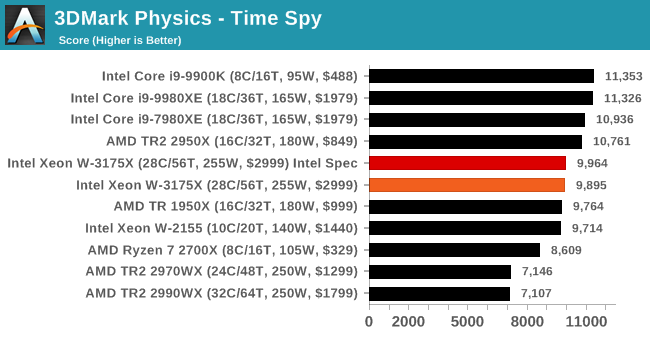
.
GeekBench4: Synthetics
A common tool for cross-platform testing between mobile, PC, and Mac, GeekBench 4 is an ultimate exercise in synthetic testing across a range of algorithms looking for peak throughput. Tests include encryption, compression, fast Fourier transform, memory operations, n-body physics, matrix operations, histogram manipulation, and HTML parsing.
I’m including this test due to popular demand, although the results do come across as overly synthetic, and a lot of users often put a lot of weight behind the test due to the fact that it is compiled across different platforms (although with different compilers).
We record the main subtest scores (Crypto, Integer, Floating Point, Memory) in our benchmark database, but for the review we post the overall single and multi-threaded results.
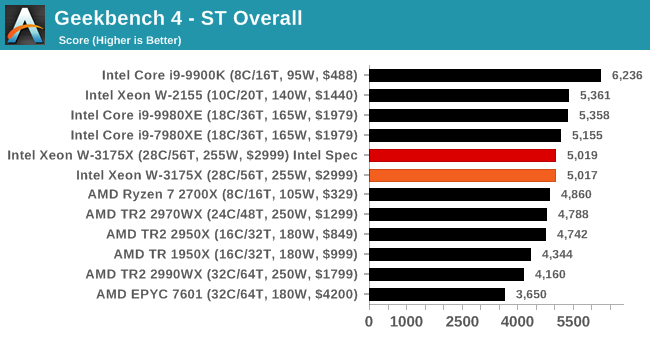
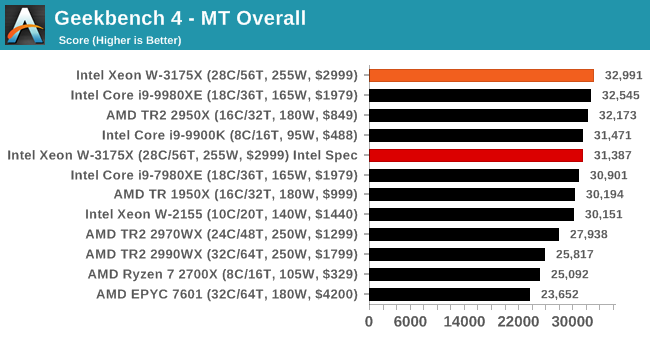










136 Comments
View All Comments
Icehawk - Thursday, January 31, 2019 - link
Yup. At the desktop level we have things like Adobe for $1k/seat/yr.Our big iron costs an order of magnitude more than these machines (recent orders were $150k ea and were mid-spec HP boxes). In the end most of the costs of a big server are memory and storage (SSDs). The high heat/energy consumption of this setup would be a concern, especially if in a colo.
jardows2 - Wednesday, January 30, 2019 - link
What are you rambling on about? It's a solid performing product, at a much reduced price than Intel's normal markup. I don't get where you come off thinking this is a fanboy post, and you totally missed my point - why is it limited to so few pieces? In Intel's lineup, it's a winner, and there are plenty of people in workstation markets who will only buy systems with Intel CPUs. So for Intel to make a good performing product, at a much lower than normal for Intel price, but only make a couple thousand of them? What's going on over there?edzieba - Thursday, January 31, 2019 - link
Because this is a cherry-picked part from a low-run die production. Intel don't make many XCC dies, and only a handful will be able to tolerate the high voltages and frequencies of this part across all 28 cores. It's also not going to be a big earner at $3000, that may break even on production but probably a loss overall when you take R&D into account.mapesdhs - Saturday, February 2, 2019 - link
A movie company I know buys systems in such bulk, a CPU/system like this wouldn't even show up on their radar. They prefer systems they can buy lots of, for multiple sites with a common setup.People are arguing here about A vs. B, about the CPU cost, but as many have pointed out it's often the sw cost and availability which determine what a company will purchase. As for workstation use, especially the prosumer market, that has its own set of issues, especially whether a particular app is written well enough to exploit so many cores. Blender is, but Premiere isn't.
FMinus - Friday, February 1, 2019 - link
Or you can get two TR 2970W system and make them work in tandem for what I would think would be almost half the price at this point, considering you can buy this Intel gem only pre-built for probably well bloated prices.SanX - Friday, February 1, 2019 - link
Intel are killing good at particle movement -- 4x faster then TR2. Till AMD makes AVX512 they are still dead for scienceET - Wednesday, January 30, 2019 - link
I find it amazing how application dependent performance is. Whether a product is a good buy depends so much on precisely what you're going to do with it, down to the application level.Still, on the whole, it looks like Intel has little to offer over AMD's much cheaper Threadripper platform.
BigMamaInHouse - Wednesday, January 30, 2019 - link
I think soon we gonna see "Leaks" about new TR64 cores, this "5GHZ 28C" stunt made AMD to release 2990WX instead just 24C 2970WX, now after the Fail attempt by Intel - We gonna see new leaks :-).FMinus - Friday, February 1, 2019 - link
Considering AMD was attending the same trade show, where Intel announced this 28 core chip and AMD a day later announced the new TR lineup, I'd say AMD planned to release the 2990WX regardless of what Intel had.mapesdhs - Saturday, February 2, 2019 - link
Yes, but the tinfoil hat industry is strong. :D